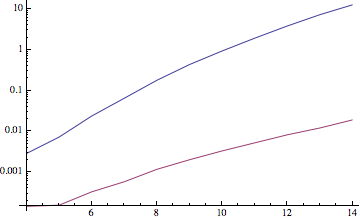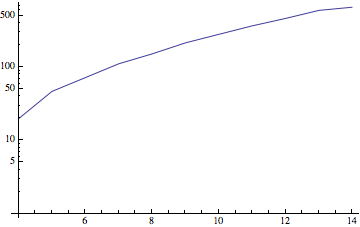I am interested in the tensor product $\hat{B} = A \star B$ (which at least I know as Rayleigh product), defined with components
\begin{equation} \hat{B}_{i_1 i_2 ... i_ n} = \sum_{j_1 = 1}^d \sum_{j_1 = 1}^d ... \sum_{j_n = 1}^d A_{i_1 j_1} A_{i_2 j_2} ... A_{i_n j_n} B_{j_1 j_2 ... j_n} \ . \end{equation}
How would you implement this efficiently for tensors of arbitrary order? The following rude implementation using TensorProduct and TensorContract is just slow
rp1[A_, B_] := Block[
{n, temp, ind},
n = TensorRank[B];
temp = ConstantArray[A, n];
AppendTo[temp, B];
ind = Table[{2*k, 2*n + k}, {k, n}];
TensorContract[TensorProduct @@ temp, ind]
];
For example
n = 4; (*tensor order*)
d = 4; (*dimension*)
A = RandomInteger[{-10, 10}, {d, d}];
B = RandomInteger[{-10, 10}, ConstantArray[d,n]];
AbsoluteTiming[res1 = rp1[A, B];][[1]]
0.146019
For fourth-order tensors you can do this as
rp2[A_, B_] := Block[
{dim, i1, i2, i3, i4},
dim = Length[A];
Table[
B.A[[i4]].A[[i3]].A[[i2]].A[[i1]]
, {i1, dim}, {i2, dim}, {i3, dim}, {i4, dim}]
];
which is a lot faster
AbsoluteTiming[res2 = rp2[A, B];][[1]]
res1 == res2
0.0023153
True
I am sure, I just dont have the right perspective on this, but how would you implement this for tensors of arbitrary order?
EDIT: This is just based on yarchik's answer (please see his answer), just to give the code for general tensor order/rank
rp[A_, B_] := Block[
{n, it, t1},
n = TensorRank[B];
it = RotateLeft@Range[n];
t1 = B;
Do[t1 = TensorTranspose[A.t1, it], {i, n}];
t1
];
Testing
n = 4; (*tensor order*)
d = 10; (*dimension*)
A = RandomInteger[10, {d, d}];
B = RandomInteger[10, ConstantArray[d, n]];
AbsoluteTiming[res1 = rp[A, B];][[1]]
AbsoluteTiming[res2 = rp2[A, B];][[1]]
res1 == res2
0.00277906
0.770904
True


